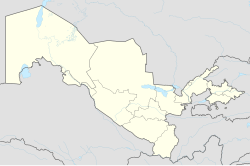Nukus
|
Nukus Uzbek: Nukus / Нукус Karakalpak: No‘kis / Нөкис |
|
|---|---|
| Location in Uzbekistan | |
| Coordinates: 42°28′N 59°36′E / 42.467°N 59.600°ECoordinates: 42°28′N 59°36′E / 42.467°N 59.600°E | |
| Country |
|
| Province | Karakalpakstan |
| Government | |
| • Type | City Administration |
| Population (2004 est.) | |
| • Total | 260,000 |
Nukus (Uzbek: Nukus / Нукус; Karakalpak: No‘kis / Нөкис; Kazakh: Нөкіс; Russian: Нукус) is the sixth-largest city in Uzbekistan, and the capital of the autonomous Karakalpakstan Republic. It has a population of 271,400 (2010 estimate). The population of Nukus as of April 24, 2014 was approximately 230,006. The Amu Darya river passes west of the town.
The city is best known for its world-class Nukus Museum of Art.
The name Nukus is associated with the old tribal name Uzbeks - Nukus. Nukus developed from a small settlement in 1932 into a large, modern Soviet city with broad avenues and big public buildings by the 1950s. The city's isolation made it host to the Red Army's Chemical Research Institute, a major research and testing center for chemical weapons.
Nukus is host to the Nukus Museum of Art (also known as the State Art Museum of the Republic of Karakalpakstan, named after Igor V. Savitsky) and State Museum. The State Museum houses the usual collection of artifacts recovered from archaeological investigations, traditional jewelry, costumes and musical instruments, but more interestingly, displays of the area's now vanished or endangered flora and fauna, and on the Aral Sea issue. The Art Museum is noted for its collection of modern Russian and Uzbek art from 1918-1935. Stalin tried his best to eliminate all non Soviet art from this period, and sent most of the artists to the gulag. Both Savitsky himself and the collection at Nukus survived because the city's remoteness limited the influence and reach of Soviet authorities. The documentary film The Desert of Forbidden Art is all about the collection and its history.
...
Wikipedia

